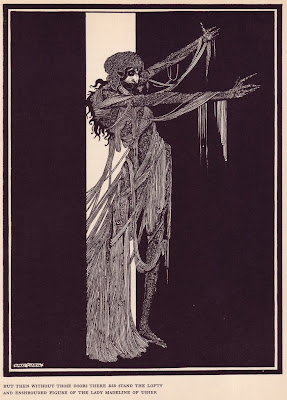






''Clarke was born in Dublin in 1889. His father was a craftsman who produced, among other objects d'art, stained glass windows. Most know Clarke's work from his drawings which are all too often and all too unfairly compared to Beardsley, but it was as a stained glass designer and artisan that he devoted the most of his too-short life. He studied in his father's studio and for a short time in London. In 1907 he was exposed to the works of Beardsley at the Irish International Exhibition, but was likewise entranced by the art of Rossetti, Annie French, E.J. Sullivan and others. By 1909 he was accepting the occasional graphic commission and working at the more creative and critical aspects of the stained glass process. That same year he was awarded a Scholarship in Stained Glass and commenced daily classes with A.E. Child at the Dublin Art School.''



''His first entry to the Board of Education National Competition won the Gold Medal in the stained glass competition in 1910. It was The Consecration of St. Mel, Bishop of Longford, by St. Patrick, as seen at left, and demonstrates the maturity he displayed early on in his chosen field of endeavor. His education continued via scholarship and he won the Gold Medal for stained glass in the National Competition three times. After his three year course, he traveled to London where he began his illustrative career with two major efforts that never saw print: The Rape of the Lock and Rime of the Ancient Mariner. The former was a private commission that raises a lot of questions. Beardsley had illustrated the poem not 20 years prior and comparisons would have been inevitable due to the stylistic similarities. It strikes me as perhaps a youthful challenge that Clarke dared not refuse. It may never have been intended for publication and the extant images are not that impressive. The Rime of the Ancient Mariner was much more mature and displayed the density of texture and design that would be his trademark.''





''While in London in 1913, he made the rounds of the publishers looking for illustration work. He met with no success at a dozen publishing houses. Then George Harrap divined his genius and hired him, on the spot, to provide illustrations for an edition of Andersen's Fairy Tales in both a trade and deluxe edition - almost unheard of for an untested, unknown and very young illustrator. The image at right is from The Nightingale and shows Clarke's debt to both Dulac and Nielsen. The Rime was put on hold and work began immediately on the Andersen. This was to occupy several years and finally see print in 1916, the same year that The Rime project was abandoned after most of the drawings and all of the blocks were destroyed in a devastating Dublin riot called the "The 1916 Easter Rising." By this time, however, Harry was already planning and working on Tales of Mystery and Imagination by E.A. Poe.''




''Swinburne was published in 1928, giving him a total of six major books illustrated in 15 years. Compare that to the more than 130 stained glass windows that he and his studio designed and crafted and it becomes very evident where his passions lay. His techniques and talents in glass often surpassed the drawing skills of other artists. The colors, patterns and expressions surpass much of what was being published at the time. And this is merely a small portion of one half of one of eight panels of one stained glass job.''


''Ill-health plagued him much of the last years of his life. He worked at a feverish pace creating glass and book illustrations while trying to maintain his father's decoration studio, which he and his brother Walter ran after the untimely death of their father in 1921. In 1930, shortly before his death, he split the stained glass business off from the decorating business and closed the latter. Walter died in July and Clarke worked even harder, despite his own frailty, to inspire confidence in his newly formed studio. He died in early 1931 while trying to recuperate from his efforts. He was 41.''

Nicola Gordon Bowe, 1979 Douglas Hyde
Nicola Gordon Bowe, 1983 Dolmen
Nicola Gordon Bowe, 1989 Irish Academic Press
source of text & more on Clarke


